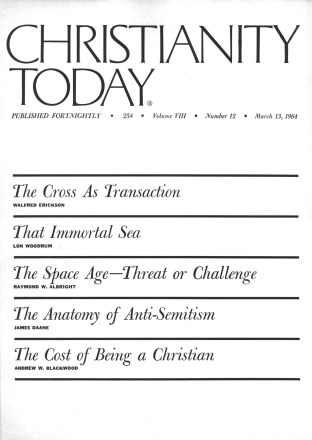The essence of the Christian religion and the heart of its message may be found in two questions from the Bible: “Adam, where art thou?” (Gen. 3:9) and “What think ye of Christ?” (Matt. 22:42). Here is the evidence for the long-held conviction that God is constantly seeking man in all that he has created and directed through the centuries and that man’s greatest opportunity in response is to accept the full revelation of God and his purposes in Jesus Christ.
A boy of six disillusioned with Santa Claus said, “I’m going to look into this Jesus Christ business.” Good. It is well that we constantly examine the ground of our faith. This is our Protestant heritage! Insofar as the space age forces us to maintain this critical attitude and helps us make this examination by providing better tools to do it, it is a proper challenge and at the same time a great blessing.
But the space age can easily be a threat. It can drive us to an over-defensive position where we ignore its challenge and reject its claims. To be unwilling to have our faith tested in the severest heat and under the most corrosive and abrasive tests of modernity is to be threatened from the conservative right.
Or we may be threatened in another way if in our agreement to hear fairly every point of view, in our attempt to be completely objective and so to curry the favor and confidence of scientists, we become unwilling to make any assumptions or to defend any positions we cannot logically explain. This is the threat from the left, and it leaves us impotently and idly standing by while the race is won by those whose mastery of this technique exceeds our own and whose results are far more significant than ours for man’s material interests. How can anyone possibly be interested in a God who we have brilliantly proven by the best scientific method is neither “out there” nor “down here” and therefore perhaps is not at all!
In this modern age, so feverishly busy in probing the vast areas of space that under increasingly proficient observation seem to be approaching almost infinite limits, it is thus readily possible that many Christians may be threatened by pressure from the right to be overly defensive and from the left to be overly neutral.
One of our responsibilities, in addition to our natural concern for those outside the churches, is to speak to those in the churches who fall into both threatened groups. In each case we can show that the Gospel need not be defended to retain intellectual respectability, but that it may indeed, if declared with confidence and clarity, become the way of hope and salvation for all men.
In response to our opportunity to assert the Christian faith for those who have not come into the Church the illustrations will be varied, but the central declaration of the Gospel remains the same.
Confronting Modern Life
Moreover, we must face squarely all the facts of life; seek out honestly the strengths and weaknesses of contemporary living, including space ventures and all other perspective-stretching experiences; and thus see whether indeed the Christian faith has anything to say and, if it does, what.
It is an altogether fascinating experience to be alive at this moment. The understanding of our universe and our ways of life in it has changed more since my boyhood days in Pennsylvania than it had previously in all the years since Roger Bacon opened Pandora’s scientific box in the thirteenth century. And now we have just seen the pictures of the greatest galactic explosion man has ever observed, giving birth to galaxy M-82, in every dimension larger than our Milky Way. The explosive force equal to some five million suns has propelled these cosmic particles at a speed of 20 million miles per hour. The specialists at Mount Wilson observatory estimate that this explosion had been going on at least 1½ million years at the time the light impressed on their photographs left there. And since M-82 is 60 million, million, million miles from earth or ten million light-years away, the explosion recently photographed actually occurred ten million years ago.
On this scale of thought it does not matter much that the soup was cold at lunch or that the Dodgers beat the Yankees; but it is important that cosmic causes and absolutes be considered in relation to ourselves and all that we experience and learn.
In the face of such inexplicable infinite forces it makes good sense to assume a common source for all our being and a common goal and constant purposive direction in history toward that end. This means the assumption of one we call God, one who is of an infinitely higher order than ourselves but who intends that in all this vastness man is of supreme worth. He limited his own will in us and for us risked his own perfect love in Christ, even though it inevitably led to a cross.
How does one bring a faith that seems so natural at the level of the cosmic mysteries to reality in a finite situation? What can God mean to men who are accustomed to supply their needs and desires by instruments and materials of their own devising and to die of a heart attack if the production schedule lags?
Through the years Christian thinkers have sought this ultimate meaning in life by trying to separate the irreconcilable elements from their faith. This has led to an appreciation of reason as a proper instrument to examine the truth of experience, even though man’s unaided reasoning is necessarily limited by his finiteness. But no matter how erudite he has become or how far he has traveled into or photographed the vast areas of space, man has never been able to escape the eternal questions: “Adam, where art thou?” and “What think ye of Christ?” The faith that God is concerned for man and is eternally searching for him, and that in Christ he has provided the best and most complete way to find him, makes life meaningful and worth living in our exciting space age.
As we come more and more to see that all being in macrocosm or microcosm is one, the assumption of one common source of truth becomes as satisfactory as the assumption of one source of being; indeed, we see that they are the same source. It follows that both being and truth exist by proceeding from their source; this we call creation in matter and revelation in knowledge.
To discover matter is not to create it; to perceive truth is not to invent it. Only the most presumptuous among us would dare to assert that man creates truth. That which man discovers has long existed and has long been giving the evidence that only now man has perceived. The religious man names his source of being and truth, God. The disclosure of God’s will and way to man is revelation, and faith is the activating agency by which reason perceives the eternal truth. Faith holds the truth in embryo until the Holy Spirit illumines it to become fully revealed truth.
Since the Middle Ages men have been struggling to place reason and revelation in a satisfactory perspective, and Vatican Council II is still debating the issue. Scotus asserted that what one cannot attain by reason one must accept on the authority of tradition in the Church. Ockham held that Scripture is the final authority in such a dilemma. Aquinas was probably nearer our position when he admitted that the truth of God cannot be fully known by man through reason. Yet he came as close as anyone to writing a rational defense of Christianity, only to leave it unfinished and to admit it could never be done. After an ecstatic religious experience while celebrating the Holy Communion, he declared that what he had seen that day made all he had written mere trash, and that he would not write another word. Written from such a rich empirical background, the Summa of Thomas Aquinas became the most adequate thirteenth-century statement of Christian truth. Our neighbors wait eagerly and anxiously for someone with an equally valid experience of Christ to tell about His significance for our space age.
Apex Of Revelation
A sleepless crying boy told his mother he was afraid. “God is here with you,” she said. And he replied, “But I want somebody with a face.” Just so. For many men God is a very vague concept; but the situation is very different when we say God and think Jesus Christ! The Christian position through the centuries has been that God’s revelation of his truth is to be found in his creation indeed, but more specifically and most perfectly and completely in his Son, Jesus Christ. Even though here, too, we have never fully perceived God’s truth and love in Christ, yet in him he had a face, and through Christ we hear God’s voice and know his love, so that we may respond more confidently in faith and prayer and commitment.
The good news of the truth of God in Christ is ours, not to alter or to explain or even to supplement or annotate, but to declare with clarity. Let the trumpet give no uncertain sound! Here is the terrible danger in the space age: that Christian ministers may be found vainly trying to win the acceptance of scientists and philosophers by using only their limited tools and limited inductive methods.
Equally dangerous it is, of course, to refuse to come to terms with our times, to live on in only the inherited thought forms of Geneva, Augsburg, or Canterbury, in the vain hope that in maintaining old ways we are certain to defend the old eternal truth. Not so! It is possible, however, to live by the essence of the eternal truth of God and to state this truth in our modern language and concepts, so that the Gospel may be so understood that we live by it in faith.
The Gospel centered in God’s love for all men, when it is announced with maximum clarity, will satisfy not only the mind of the scholar but also the heart of the saint.
Raymond W. Albright is the William Reed Huntington Professor of Church History in the Episcopal Theological School, Cambridge, Massachusetts. Professor Albright has served as visiting professor at the University of Marburg (Germany) and at Boston University. His most recent books are a biography of Phillips Brooks and “A History of the Protestant Episcopal Church.”










